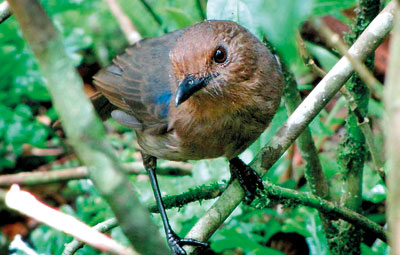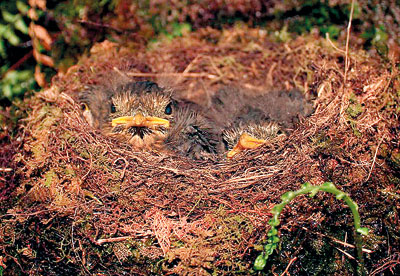Crouched in a camouflaged bunker he had made himself in the cloud forests of the Knuckles Range, the hours of cramped discomfort stretched into days and then months, not only assailed by the chilly winds that left him cold to the bone but also the hordes of blood-sucking leeches which clung even to his head.
Often with only a chocolate slab to appease his hunger and holding back his urge to answer the call of nature, not heeding the fact that his kidneys were already damaged from a polonga-bite suffered on one of his many forays into the jungle earlier, researcher Pradeep Samarawickrama was on a quest.
A quest which not only consumed his whole being but also coaxed his wife, Shiromi, to leave their home and be by his side on several occasions in this spectacular but difficult terrain where other humans are hardly encountered, after having heard the whistling call sounding like sree.
 |
| The elusive Whistling Thrush. Pix by Pradeep Samarawickrama |
Hearing but not seeing the endemic Sri Lanka Whistling Thrush or Sri Lanka Arrenga (Myiophonus blighi), falling into the ‘Endangered’ category of the IUCN’s National Red List (2007) and Global Red List (2011), it was back in March 2004, while on a camping trip close to a waterfall in the Knuckles Conservation Area, that Pradeep was intrigued. For the first time, he glimpsed through his binoculars, in 13°C cold weather in the early morn, a single female Whistling Thrush hard at work, carrying twigs and leaves, disappearing behind a small waterfall, intent on building a nest.
With habitation loss being attributed to the decline in numbers as far back as 1942 by Jean Delacour; Colonel William Vincent Legge describing it as “one of our rarest hill-birds” in 1980; and a survey of over 200 forest patches during 1991-96 recording this species only from four sites, Pradeep was determined to uncover the misty layers surrounding the Whistling Thrush.
“I decided to study the life-cycle of this bird found in mountainous areas which are difficult to access,” says Pradeep, explaining that of particular interest was its breeding and nesting ecology.
There are six Whistling Thrush species in the world with Sumatra having three species, the Malay peninsula and Java two each and Continental Asia, Taiwan, Borneo and Sri Lanka one each.
On another camping trip with his wife, they saw in the sunlight glimmering off the waters of another fall in the same Knuckles area, another bird with nesting material in her tiny beak. Quickly removing their tent so as not to disturb the bird, they watched in wonderment through binoculars.
That image further strengthened his resolve to take up the quest of studying these birds – the nesting, laying of eggs, the birth of the baby birds and their introduction to the world.
Having undertaken to do the study through the Peradeniya University with research collaborators Prof. K.B. Ranawana, Professor of Zoology, Shiromi Samarawickrama (his wife who has just completed her M.Sc) and Dr. M. Meegaskumbura and armed with a small grant from the university as well as research permits from both the Forest Department and the Department of Wildlife Conservation, Pradeep was back at Knuckles in 2010 and 2011 to fulfil his quest. He also had a helping hand from the Onset Computer Corporation which provided him the External Temperature Data Logger kit and the IDEA WILD organization which provided the Bushnell Trophy Cam and binoculars.
Lugging everything he needed including a small cooker and food in his backpack, he would take a bus to the Knuckles boundary and trek about eight km interior. In the stillness, he would quietly, without disturbing the surroundings, put up a tent on a gal talawa to begin his lonely vigil.
 |
| Safe and snug:The chicks |
About 30-feet from the nest, I made a “hide”, says Pradeep, explaining that it was a basic camouflaged bunker made of rotting branches and leaves shed from the nelu trees in the jungle. “I was sensitive to the fact that the birds would be scared off and abandon their nest if they sensed any kind of activity that was unusual in the area,” he says.
During the nesting season, he would spend eight long days and nights here and go back to his wife and two small daughters in Kandy for five days.
Not counting a broken leg after falling down a precipice in his sojourns in the Knuckles and unease at finding his tent being inexplicably opened but nothing missing in an area with no humans around, Pradeep is thrilled about his exclusive photographs of the rare Whistling Thrush, having conducted detailed studies of two nests in close proximity – with one baby and two baby birds each. Such research has not been done in about 150 years, he believes.
With Bird Life International reporting in 2010 that the total population of the Whistling Thrush in Sri Lanka would be around 1,000-2,499, Pradeep has set his sights on another quest for 2012.
“I want to study nest predation,” says Pradeep, adding that after the nests had been abandoned by the birds, he found that some “unknown quantity” was removing the nests.
Is it a human or creature, is what Pradeep wants to find out.
Thrush facts
The facts about the Sri Lanka Whistling Thrush that Pradeep’s detailed photographs and notes reveal:
- This “shy” bird is small, the size of a mynah, and black. While the male’s head and body are black and the lesser wing-coverts have lighter blue patches, the female is chestnut brown above and reddish below, with blue lesser wing-coverts and a slight blue suffusion on the black and wings. The baby birds are reddish brown, mottled on head and breast. There is no white on the flank feathers.
- The nest of green moss (Aerobryopsis sp. of the family Meteoriaceae and Thuidium sp. of the family Thuidiaceae), small leaves and roots was on a rock crevice 2m above the ground, covered with moss ferns, overhanging a small waterfall and before building it the female cleared the base of the rock. Bringing the material from locations away from the nest-site, the female stopped at several points probably to mislead possible nest predators. Preferring to work after heavy rains or when the light intensity in the area dropped and the flow of water in the stream was loud, the female slowed down on sunny days, resting in the shade on the ground. The male remained close-by but did not take part in the nest-building which lasted three weeks.
- The nest cup 55mm deep and 220mm in height had a thickness of 58mm and an inner diameter of 82mm. The exterior was of moss and the interior lining of black rhizomorph fibres.
- On returning to the site in early May 2010, two off-white eggs (with reddish-brown blotches concentrated around the blunt end) were found in the nest. The eggs differed slightly in size (29.85 X 18.97 mm and 27.7 X 17.6 mm) and were relatively smaller than previously reported. One egg hatched in mid-May but the other did not, with the nestling opening its eyes six days later.
- The hungry hatchling was fed gourmet meals comprising 35 items including frogs, lizards and insects by both parents. The chick left the nest 19 days after hatching. Day time nest temperatures varied from 20.5 to 26ºC on a single day when the outside temperature (air temperature) varied between 18 to 20ºC on the same day. The night-time nest temperature (when the adult was in the nest) varied between 21 to 25ºC when the external temperature varied between 18 to 20ºC during the same period.
|



